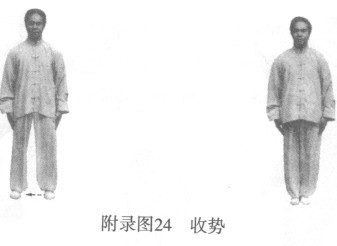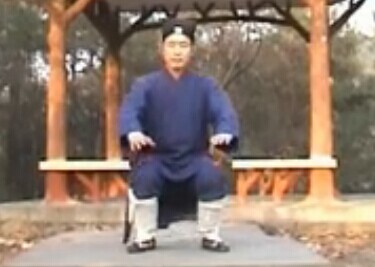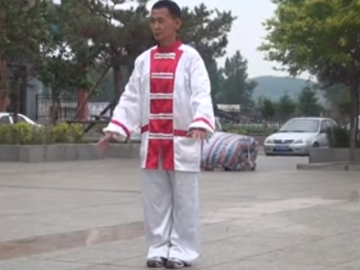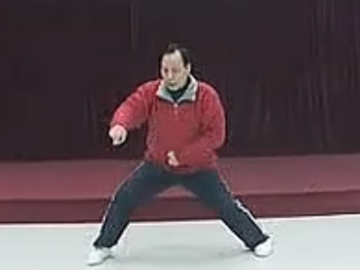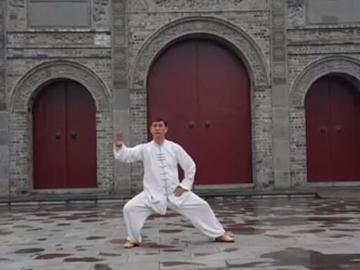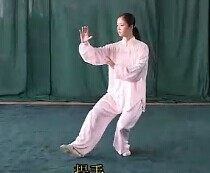一、大脑支配下的意气运动 大脑支配下的意气运动,说明气是受意的指挥。此处所谓的 气,是一种内气,不是人肺部呼吸的气。这种内气,中医理论认 为是从母胎中秉承而来的,叫做元气、正气、先天气等。武术家 把这种气叫做中气、内气、内劲等。陈氏称此气谓中气,是人所 秉受于天,本来之元气。陈鑫的《中气辩》与《中气与浩然之气 血气辨》两篇已讲得很明白。意是意识,是属于精神现象,亦谓 之意念,古人谓之心,是脑的代称。因此用意即是用心,以意行 气,即是以心行气。所以拳谱说: “以心行气,以气运身。”
l.Features of Ghen Style Taiji Quan 1. The Movement of Yi and Qi Are Controlled by the Brain. The movement of Yi and Qi are controlled by the brain, which means Qi is controlled by the mind. Here, Qi refers to Nei Qi (Internal Qi) and not the air breathed by the lungs. According to traditional Chinesemedical science theory, Nei Qi already exists while the individual is still in hismother' s womb, so it is also called Yuan Qi, Zheng Qi, Xian Tian (from birth) Qi, etc. In martial arts, it is named as Zhong Qi, Nei Qi, Nei Jin (Internal Energy). In Chen Style Taiji Quan, it is named as Zhong Qi that came from the womb and it is the first energy of a human being. Yi is the mind, belonging to the 'spirit' phenomenon; it was called Xin (heart) in ancient times, but it is actually the brain. Therefore, using Yi means using Xin. Qi is moved by Yi, which means Qi moved by Xin. That is why the specification of Taiji says that "Xin drives Qi and Qi drives the body".
我们知道了意和气的意义,那么打拳时的每一动作,须先要 经过大脑的想象,这就是用意,练习日久,自然觉得有气。太极 拳的一动一静,促使人体生物电位升降。电位升高,则血液循环 加速,血压降低,氧与血红蛋白也就迅速离解,人就会感觉到有 气。这就是所谓内气的发生。这个气是听意的指挥,所以说,练 太极拳是用意行气。至于呼吸之气,要任其自然,不可故意做 作。呼吸要配合动作的开合,开则用呼,合则用吸,并使呼吸之 气由丹田出入。 陈氏太极拳用腹部呼吸,动作的缓急与呼吸配合,有丹田内 转的作用,不是单纯的气沉丹田。太极拳的一举一动用意不用 力,先意动,而后形动,这样才能做到意到气到,气到劲到,动 作沉着,久练之后,气才能收敛入骨,达到深奥的境界。 Chen Style Taiji Quan uses the abdomen to breathe. The quickness or slowness of the movements are coordinated with the breathing. Qi turns in the Dan Tian instead of simply sinking. All the movements use Yi, not the force Li. Move Yi first, then the body. When Yi arrives, Qi amves, and Jin (Internal power) ar- rives, and the movements are steady and powerful. After years of exercise, Qi will be absorbed by the bones and one' s skills will reach a high level. 奎于所说的气到劲到的劲,是经过锻炼太极拳后获得的,所 以只要意到气就到,气到劲也到。因此太极拳是一种“以心行 气,以气运身”和“用意不用拙力”的意气运动。拳论讲: “心 如将军,气如兵,将军一出令,则士卒皆听命”。心是发令的, 气是奉令而行的,气再运动身肢,所以叫做: “以心行气,以气 运身”。 As to Jin (internal power), which is mentioned above, it comes from practicing Taiji. Taiji Quan uses Yi to lead Qi, Qi to lead the body, but not rigid force. The specification of the Quan says that¨Xin is a general; Qi is a soldier. Once the general commands, the soldier must fol- low”. 二、身肢放长的弹性运动 弹性运动提出了将身肢放长的方法。方法是: (1)虚领顶 劲和气沉丹田; (2)含胸拔背(忌弓背); (3)沉肩坠肘; (4)开胯屈膝的旋转。这四个方法是使身躯、脊背、手臂、腿部 的放长。肌肉在受力时,可以有一定程度的伸长,但当引起伸长 的外因消除后,肌肉就立刻恢复原状,这是肌肉本身固有的一种 弹性,太极拳就是锻炼这种肌肉的弹性,经久放松与收缩的锻 炼,也就能自然地加强身肢各部分的弹性,同时也提高了身体的 素质;对于生理健身说可以使血管畅通,增强新陈代谢和气体的 交换,能得到更多的氧气,降低血压,防止血管硬化;对于技击 方面,由于曰久锻炼这种肌肉弹性,可以产生一种拥劲。 2. Elastic Movement to Expand the Body Elastic movement helps expand the body. That is: A) Draw the head up naturally; sink Qi (energy) to the lower abdomen. B) Draw the chest in and stretch the back (Do not bow the back).C) Relax the shoulders and sink the elbows. D) Push the hips outward; bend and rotate the knees. These are four ways to expand the body, the back, the arms and legs. When a muscle bears force, it can be expanded; when the force is removed, the muscle returns to its original state, which is the muscle' s natu- ral elasticity. Taiji Quan aims to improve the muscle' s elasticity. Through the long time exercise of relaxing and contracting, the e一 lasticity of the body will be strengthened naturally; at the same time, the health will be improved. For health, elastic movement strengthens the blood vessels and increases their ability to absorb more oxygen, decreases blood pressure, and Avoids angiosclerosis. As to the skills of offense and defense, Peng Jin can be achieved by repeated training of the muscle elasticity. 掤劲是太极拳劲的基础,无论是捋、挤、按、採、捌、肘、 靠都要有掤劲(推手的拥是对方按我,我以手臂捧住,不使下 落,有向上之意的掤)。也可以说周身都要有这种拥劲,才能够 做到当外力来时可以抵御和反击,所以太极拳有“拥劲永不丢” 之语,在陈鑫著作中说: “沿路缠绵,静运无慌,肌肤骨节,虚 虚开张。”这就是说运动时要心静不乱,动作要轻灵细腻,肌肉、 皮肤和骨节处处都要放长松开。 Peng Jin (pushing power) is the foundation of Taiji Quan. No matter if it's Lu, Ji, An, Cai, Lie, Zhou, Kao, they all need Peng Jin ('Peng' in Pushing Hands, for example, means that if the opponent presses your arm, you use your arm to pre- vent his arm from dropping, which is Peng with the intention to push upward). We can also say that our whole body needs this kind of Peng Jin, in order to resist an incoming force and strike back. The Taiji theory says: "Never lose Peng Jin" and also Mr. Xin Chen said in his book: ¨move calmly without hurry; skin and joints open gradually." which means that during the move- ment, you should be calm without rushing. The movement re- quires being light and smooth and the muscle, skin, and joints to be relaxed and expanded. 三、顺逆缠丝的螺旋运动 螺旋运动中缠丝劲的实质不是平面的一个圈,而是立体的螺 旋上升的。因为每一动作是由掌心内外翻转,表现在上肢是旋腕 转膀,表现在下肢是旋踝转腿,表现在身躯是旋腰转脊。三者结 合起来形成一条其根在脚,主宰于腰而形于手指的空间旋转曲 线。 3. Spiral Movement-Twist Inward and Twist Outward Twisting Jin (twisting power) is a spiral movement which is not moving in a circle on a plane, but a 3-dimension spiral. That is, each movement starts from the turning of the palms in- ward and outward, twisting the upper limbs (wrists and the shoulders), twisting the lower limbs (legs and ankles), and twist-
ing the body (the waist and the spine). All of above movements form a curved line rooted in the feet, controlled by the waist, and shown at the fingers. 缠丝劲的作用是可以将外来的压力因旋转而落空,在太极拳 的术语中叫做化;同时还可以牵动对方的重心而乘势反击,术语 叫做发。 The function of Twisting Jin is to frustrate or to negate an incoming force (external pressure) through rotation. In Taiji Quan, this called Hua (transformation). At the same time, Twist- ing Jin can also cause an opponent to lose balance and take a chance to strikee him. This term is called Fa (issuing). 在生理健身方面,这种螺旋形的缠丝劲能促使全身节节贯串 地推动,对内脏器官能起一种按摩的作用,使显于外的神气发生 鼓荡,因而可以健强大脑皮层,增强全身一切组织器官的功能: 缠丝劲的种类可分为基本的顺逆缠丝和方位的进退、大小、里 外、上下、左右等五对缠丝。顺逆缠丝劲表现于上肢手臂者,是 顺缠手心转向自己面部,逆缠手背转向自己面部。表现于下肢腿 部者,是顺缠膝部由内转向外,逆缠膝由外转向内。 In the physical fitness (health) aspect, Twisting Jin causes every part of the body to move, benefits the internal organs, anc

